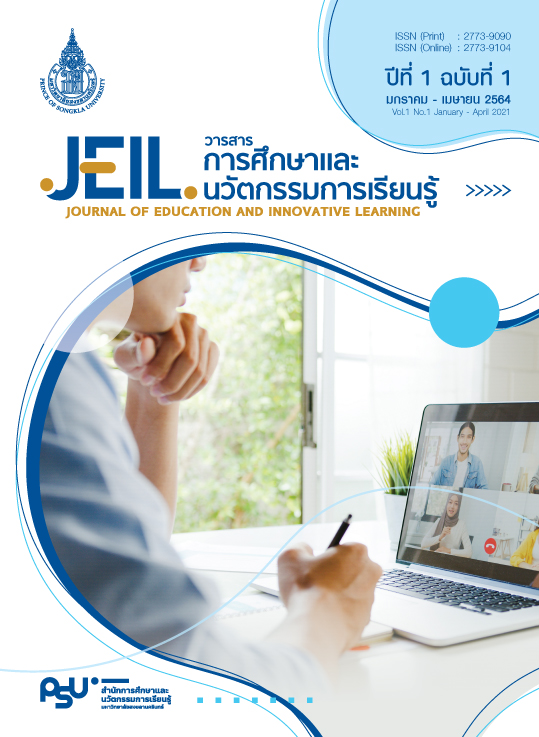สภาพแวดล้อมการเรียนรู้เสมือนผ่านพื้นที่ทำงานร่วมกันอัจฉริยะ
Main Article Content
บทคัดย่อ
บทความนี้มีวัตถุประสงค์เพื่อสังเคราะห์หลักการและแนวคิดที่เกี่ยวข้องกับสภาพแวดล้อม
การเรียนรู้เสมือนผ่านพื้นที่ทำงานร่วมกันอัจฉริยะ ผลการศึกษาพบว่า สภาพแวดล้อมการเรียนรู้เสมือนและพื้นที่ทำงานร่วมกันอัจฉริยะมีองค์ประกอบที่มีความสอดคล้องกันและสามารถนำมาประยุกต์ใช้ร่วมกันได้คือ องค์ประกอบสภาพแวดล้อมการเรียนรู้เสมือนในด้านช่องทางการติดต่อสื่อสารอาศัยทรัพยากรดิจิทัลและการสื่อสารผ่านอินเทอร์เน็ตเป็นสำคัญ ซึ่งสอดคล้องกับเทคโนโลยีสนับสนุนพื้นที่ทำงานร่วมกันอัจฉริยะในเรื่องของ การเชื่อมต่อไร้สาย, ซอฟต์แวร์ประยุกต์, อุปกรณ์พกพา และข้อมูลดิจิทัล ในส่วนของเนื้อหาบทเรียนและการประเมินผล ซึ่งสอดคล้องกับเทคโนโลยีสนับสนุนพื้นที่ทำงานร่วมกันอัจฉริยะที่ใช้เทคโนโลยีในเรื่องของ ซอฟต์แวร์ประยุกต์ และข้อมูลดิจิทัล ในเรื่องขององค์ประกอบการสื่อสารที่ใช้ในสภาพแวดล้อมการเรียนรู้เสมือน ซึ่งประกอบไปด้วยผลป้อนกลับ กระดานสนทนา การมีปฏิสัมพันธ์ และเครือข่ายสังคมออนไลน์จะสอดคล้องกับ เทคโนโลยีสนับสนุนพื้นที่ทำงานร่วมกันอัจฉริยะทั้งสี่ด้าน คือ การเชื่อมต่อไร้สาย ซอฟต์แวร์ประยุกต์ อุปกรณ์พกพา และข้อมูลดิจิทัล ในส่วนของคน ในองค์ประกอบสภาพแวดล้อมการเรียนรู้เสมือน ได้แก่ ผู้เรียนและผู้สอน อาจต้องมีซอฟต์แวร์ประยุกต์และอุปกรณ์พกพาเพื่อเข้าถึงพื้นที่ทำงานร่วมกันอัจฉริยะ
Article Details

อนุญาตภายใต้เงื่อนไข Creative Commons Attribution-NonCommercial-NoDerivatives 4.0 International License.
เนื้อหาและข้อมูลในบทความที่ตีพิมพ์ในวารสารการศึกษาและนวัตกรรมการเรียนรู้ ถือเป็นข้อคิดเห็นและความรับผิดชอบของผู้เขียน ซึ่งกองบรรณาธิการวารสาร ไม่จำเป็นต้องเห็นด้วยหรือร่วมรับผิดชอบใด ๆ และไม่สงวนสิทธิ์การคัดลอกบทความเพื่อใช้ประโยชน์ทางวิชาการ แต่ให้อ้างอิงข้อมูลแสดงที่มาของบทความทุกครั้งที่นำไปใช้ประโยชน์
เอกสารอ้างอิง
Alkhafaji, A., Fallahkhair, S., & Haig, E. (2020). A theoretical framework for designing smart and ubiquitous learning environments for outdoor cultural heritage. Journal of cultural heritage, 46, 244-258. https://doi.org/10.1016/j.culher.2020.08.006
Alves, P., Miranda, L., & Morais, C. (2017). The influence of virtual learning environments in students’ performance. Universal journal of educational research, 5(3), 517-527. https://doi.org/10.13189/ujer.2017.050325
Boulton, C. A., Kent, C., & Williams, H. T. P. (2018). Virtual learning environment engagement and learning outcomes at a ‘bricks-and-mortar’ university. Computers and education, 126, 129-142. https://doi.org/10.1016/j.compedu.2018.06.031
Chua, E. R., Sibbaluca, B. G., Mack, M. R., & Militante, S. V. (2020). Technological strategies in teaching: Towards the design of virtual learning environment. International journal of scientific and technology research, 9(4), 2127-2130.
Dreher, A., & Kuntze, S. (2015). Teachers’ professional knowledge and noticing: the case of multiple representations in the mathematics classroom. Educational studies in mathematics, 88(1), 89-114. https://doi.org/10.1007/s10649-014-9577-8
Ersoy-Babula, A. I., & Babula, M. (2018). Learning on the move business students’ adaptation of virtual learning environment and mobile device technology. International journal of management education, 16(2), 321-326. https://doi.org/10.1016/j.ijme.2018.04.007
García-Álvarez, M. T., Novo-Corti, I., & Varela-Candamio, L. (2018). The effects of social networks on the assessment of virtual learning environments: A study for social sciences degrees. Telematics and informatics, 35(4), 1005-1017. https://doi.org/10.1016/j.tele.2017.09.013
Gerdenitsch, C., Scheel, T. E., Andorfer, J., & Korunka, C. (2016). Coworking spaces: A source of social support for independent professionals. Frontiers in Psychology, 7, 1-12. https://doi.org/10.3389/fpsyg.2016.00581
Greaves, B., & Coetzee, M. (2017). Access control for secure information sharing in smart content spaces. Journal of information security and applications, 34, 63-75. https://doi.org/10.1016/j.jisa.2016.12.002
Gruppen, L. D., Irby, D. M., Durning, S. J., & Maggio, L. A. (2019). Conceptualizing learning environments. The health professions. academic medicine, 94(7), 969-974. https://doi.org/10.1097/ACM.0000000000002702
Gulkilik, H., Moyer-Packenham, P. S., Ugurlu, H. H., & Yuruk, N. (2020). Characterizing the growth of one student’s mathematical understanding in a multi-representational learning environment. Journal of mathematical behavior, 58, 1-3. https://doi.org/10.1016/j.jmathb.2020.100756
Hamid, Z., Peng, C. F., Shaharom, M. S. N., Ter, T. C., & Raman, K. (2018). The concept and use of the virtual learning environment in teaching: a literature review. International journal of academic research in business and social sciences, 8(6), 1293-1301. https://doi.org/10.6007/ijarbss/v8-i6/4517
Hamutoglu, N. B., Gemikonakli, O., Duman, I., Kirksekiz, A., & Kiyici, M. (2020). Evaluating students experiences using a virtual learning environment: Satisfaction and preferences.
Educational technology research and development, 68(1), 437-462. https://doi.org/10.1007/s11423-019-09705-z
Kopplin, C. S. (2020). Two heads are better than one: Matchmaking tools in coworking spaces. Review of Managerial Science, https://doi.org/10.1007/s11846-020-00382-4
Lee, J., & Choi, H. (2017). What affects learner’s higher-order thinking in technology-enhanced learning environments? The effects of learner factors. Computers and education, 115, 143-152. https://doi.org/10.1016/j.compedu.2017.06.015
Li, N., Wang, J., Zhang, X., & Sherwood, R. (2021). Investigation of face-to-face class attendance, virtual learning engagement and academic performance in a blended learning environment. International journal of information and education technology, 11(3), 112-118. https://doi.org/10.18178/ijiet.2021.11.3.1498
Liaw, S. Y., Soh, S. L. H., Tan, K. K., Wu, L. T., Yap, J., & Chow, Y. L., … Wong, L. F. (2019). Design and evaluation of a 3D virtual environment for collaborative learning in interprofessional team care delivery. Nurse education today, 81, 64-71. https://doi.org/10.1016/j.nedt.2019.06.012
Ma, Z., Jørgensen, B. N., & Billanes, J. D. (2021). Smart buildings and urban spaces. In J. R. Vacca (Ed.), Solving urban infrastructure problems using smart city technologies. Elsevier, 56-87. https://doi.org/10.1016/b978-0-12-816816-5.00003-6
Mcburnie, C. (2020). The use of virtual learning environments and learning management systems during the COVID-19. Pandemic, 07, 1.-16. https://doi.org/10.5281/zenodo.3805843
McGuirk, P. M., Dowling, R., & Carr, C. (2019). The material politics of smart building energy management: A view from Sydney’s commercial office space. Political geography, 74, 1-9. https://doi.org/10.1016/j.polgeo.2019.102034
Monsalve-Pulido, J., Aguilar, J., Montoya, E., & Salazar, C. (2020). Autonomous recommender system architecture for virtual learning environments. Applied computing and informatics, 17(1), 1-11. https://doi.org/10.1016/j.aci.2020.03.001
Office of the national economic and social development board. (2017). The twelfth national economic and social development plan (2017-2021). Retrieved from https://www.nesdc.go.th/nesdb_en/ewt_dl_link.php?nid=4345
Panori, A., Kakderi, C., Komninos, N., Fellnhofer, K., Reid, A., & Mora, L. (2020). Smart systems of innovation for smart places: Challenges in deploying digital platforms for co-creation and data-intelligence. Land use policy, 103, (1-7). https://doi.org/10.1016/j.landusepol.2020.104631
Papadopoulou, E., Gallacher, S., Taylor, N. K., & Williams, M. H. (2012). A personal smart space approach to realising ambient ecologies. Pervasive and mobile computing, 8(4), 485-499. https://doi.org/10.1016/j.pmcj.2011.10.008
Raposo Rivas, M., & Escola, J. (2016). Virtual learning communities: Review of a decade of spanish-portuguese scientific production. Jett, 7(1), 11-24.
Rashid, A. H. A., Shukor, N. A., Tasir, Z., & Na, K. S. (2021). Teachers’ perceptions and readiness toward the implementation of virtual learning environment. International journal of evaluation and research in education, 10(1), 209-214. https://doi.org/10.11591/ijere.v10i1.21014
Simon, B., Nejdl, W., & Sintek, M. (2003, May). Smart space for learning: A mediation infrastructure for learning services. In Gusztáv Hencsey (Chair) The Twelfth International World Wide Web Conference. Computer and Automation Research Institute, Hungary.
Spinuzzi, C. (2012). Working alone together: coworking as emergent collaborative activity. Journal of business and technical communication, 26(4), 399-441. https://doi.org/10.1177/1050651912444070
Theobald, K. A., Windsor, C. A., & Forster, E. M. (2018). Engaging students in a community of learning: Renegotiating the learning environment. Nurse education in practice, 29, 137-142. https://doi.org/10.1016/j.nepr.2017.12.008
Tseng, W. T., Liou, H. J., & Chu, H. C. (2020). Vocabulary learning in virtual environments: Learner autonomy and collaboration System, 88, (1-17). https://doi.org/10.1016/j.system.2019.102190
Varfolomeyev, A., Korzun, D., Ivanovs, A., Soms, H., & Petrina, O. (2015). Smart space based recommendation service for historical tourism. Procedia computer science, 77, 85-91. https://doi.org/10.1016/j.procs.2015.12.363
Verstege, S., Pijeira-Díaz, H. J., Noroozi, O., Biemans, H., & Diederen, J. (2019). Relations between students’ perceived levels of self-regulation and their corresponding learning behavior and outcomes in a virtual experiment environment. Computers in human behavior, 100, 325-334. https://doi.org/10.1016/j.chb.2019.02.020


